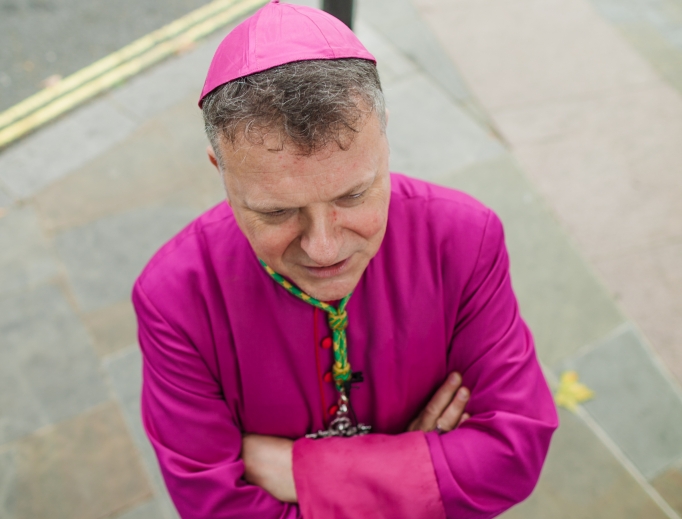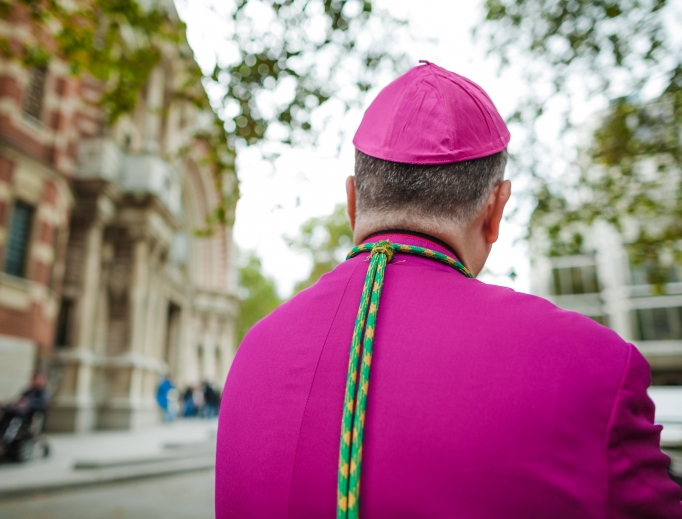Scottish Bishop Contemplates the Way Ahead Post-Lockdown
Bishop John Keenan: ‘The undoubted faith revival brought about in the midst of the pandemic is God’s doing.’

The first Scottish COVID-19 case was confirmed on March 1. Twelve days later, on March 13, Scotland recorded its first death from the virus.
As the public-health crisis grew, the Bishops’ Conference of Scotland was unanimous in wanting to keep churches open and Masses public. However, events overtook the Bishops’ Conference of Scotland. As the health crisis escalated nationally, and not wanting it left to secular authorities to ban Catholic worship, the Scottish bishops bowed to the inevitable and closed churches, suspended public Masses, postponed the sacraments of baptism and marriage, and directed that funeral rites should be restricted to gravesides and crematoriums.
On March 19, the feast of St. Joseph, the last public Masses were celebrated in Scotland.
As the country emerges from lockdown, the vice president of the Bishops’ Conference of Scotland, Bishop John Keenan of Paisley, spoke to the Register June 16 about the way ahead for the Scottish Church.

The churches are reopening, so is it “business as usual”?
The most iconic moment of the pandemic for me was the extraordinary urbi et orbi Benediction that Pope Francis gave from St. Peter’s Basilica on a deserted and rain-swept night. He reflected upon Mark’s Gospel and the storm on Lake Tiberius. I hope in this current storm, just as it had for the apostles, it will allow us to cross to the other side and, in so doing, allow us to close a somewhat unhappy chapter in the life of the Church in the past generation or so. I hope this other side is the Holy Spirit’s offer of a new beginning, opening up to us a new springtime for the Church in fairer terrain.
Many of the faithful in different countries are concerned that the decision-making process by the bishops to close and then reopen churches has not granted sufficient priority to the faithful’s desire — need — to access the sacraments, both during lockdown and now in the reopening period. How would you respond to that?
Securing the faithful’s access to the sacraments during lockdown was always at the forefront of our minds as bishops.
The Scottish bishops were keen to keep whatever lines open we could for administering the sacrament of the sick to the ill and dying in our hospitals, care residences and family homes. It was something we continually reviewed as the virus increased and abated and as hospitals restricted and then relaxed their policies for allowing visits.
Within safe guidelines, we were also keen to ensure our priests felt free to be available for individual requests for the sacrament of confession. The same was the case for the sacrament of baptism in danger of death.
We worked with our priests to ensure these sacraments were available behind the scenes and that priests were free to use their discretion in balancing public-safety concerns with the spiritual needs of those faithful for whom sacraments mattered immediately for their salvation.
When it came to public Masses and Holy Communion, the bishops were just as sorrowful we could no longer gather for our Church Liturgies. The feast of St. Joseph, March 19, marked Scotland’s final public Masses before lockdown. Those Masses were celebrated in tears, not just of our laity, but tears running visibly from the eyes of Scottish priests and bishops. For the whole Catholic faithful, celebrating Mass and sharing the Eucharist together is at the heart of who we are as God’s family; and being isolated from each other has been as painful as any other family isolation.
Many Catholics are unsure as to how their bishops are arriving at decisions in regards to the opening and closing of their parish churches. Again, how would you respond?
Of all considerations, being close to our people and keeping everyone together was the Scottish bishops’ guiding principle. It has not been easy to keep all the “fish in the net,” though. Many felt more secure in the boat, while others were bolder about getting onshore as soon as possible. Some thought their Catholic duty was to protect our God-given lives and health. Others were motivated by the requirement of Catholic social teaching to work toward the common good of the whole of society, especially the weak, and to keep our churches closed so as to slow the spread of the virus among others, especially the vulnerable.
Of course, if the Church focused only on health, too exclusively following civic authority, this would underplay the just prerogatives of the Church in organizing our supernatural polity. Then again, too determined a concern to open our churches against government guidelines may have signaled ordinary Catholics to have contempt for the civic authorities.
The Scottish bishops wanted to hold all of this together and try to steer a middle ground that would appeal to and give confidence to all our people. We did not want to lose one fish from the net, even if we were realistic enough to know we could not please everyone.
How would you sum up the practical challenges posed by reopening churches?
First, we had to collaborate with the government in such a way as to convince it we could and should safely open in the first tranche of public openings. We were well aware of voices that wanted to situate us with the likes of sports stadiums and concert halls and put us at the end of the queue. We were also determined that our churches would be the safest of all public spaces.
Secondly, we have to convince people that it is safe to come back. Clearly many are still a little afraid, for themselves and for their elderly loved ones.
And what are the spiritual challenges ahead for the Catholic Church in Scotland?
Firstly, there is the Gospel encouragement: Do not be afraid. We will reflect on the fear that gripped us during this pandemic. I think now is the time to trust not just that our bishops and priests are preparing a safe way for us to return, but that Jesus himself is preparing a place for us in his Father’s house so that where he is we can be too.
Secondly, we will reflect on what has been effectively a pandemic of New Evangelization and mission.
The Church has impressively embraced all the digital expressions of this New Evangelization with fresh ardor. It has been phenomenal to see how quickly and adeptly our priests turned their oratories into pop-up studios for Mass and devotions, spiritual reflections and catechesis. That marvel was matched only by the insatiable appetite our people showed for this Catholic online presence in their homes.
There are things we have learned that we do not want to unlearn on the road to recovery. We will reflect upon how to develop this blend of online and physical ministry in the months and years ahead.
That reflection includes understanding how we see virtual ministry. The first question to ask is whether we see the virtual as real, less real or even not real. My sense is we have discovered online ministry as a genuine new good to be maintained and developed. From now on we should place the virtual world in the “real” category rather than against it, but we need to develop a theology of the distinction between online participation and real congregations.
Finally, for now, the Scottish bishops are reflecting upon issuing a catechetical teaching on the Eucharist after the pandemic. We have seen genuine renewal in Eucharistic devotion by those who participated in online Masses, but the pandemic lockdown has raised many questions about the Eucharist. Now would be a good moment to answer them.
Weeks after lockdown began, and now as Scotland begins to ease out of it, what are your reflections as bishop and shepherd on this latest stage of COVID-19?
It is quite significant that our Church lived this pandemic mostly through Lent, Holy Week and Eastertide, when we were brought close to the wounds of Jesus.
To close our churches and liturgies, our sacraments and devotions was a real wound to Catholics that struck us low, just as the wounds of Jesus were there on display for all the world to see on Calvary. Because he offered them up, the senseless blows of the soldiers became redemptive of the sins of all the world. I sense that the wounds lockdown has inflicted on the Church have been redemptive, too. For the most part, we accepted them and offered them up.
Going forward, we do not want to lose the significance of the memory and reality of our “pandemic woundedness.” We want to take it with us as the wellspring out of which we can make our offering and give true worship and devotion to the Lord for the renewal of our faith and the rebuilding of the Church.
And how do you think the experience of reopening will shift matters again?
Because reopening will be phased, beginning with a few weeks where churches are open for private prayer, maybe with Exposition of the Blessed Sacrament, the sacrament of confession and family funerals, Catholics will be able to live their faith partly online and partly in church. We are no longer faced with a binary choice of either-or and now have the opportunity of living our faith in a blended way between online Masses, devotions and catechesis and in-church prayer and sacraments.
Beyond the practical concerns, spiritually how do we move forward?
The reality is that our Masses and devotions, our spiritual reflections and catechesis are taking place in people’s homes. Way back, but still in living memory, it used to be the case that as soon as you walked into a Catholic home you knew it was Catholic because of some religious image on the wall or mantlepiece. For the last generation of Catholics, it became unfashionable to have holy images about the house. Now they are well and truly back on our electronic screens.
The pandemic lockdown has seen the resurrection of the domestic church. Home altars have gone up again. Families gather together for Sunday Mass around the modern-day hearth.
For the first 300 years of our life under Roman imperium our outlawed Christian faith had no churches. We existed not for weeks, but for centuries, in lockdown, with Sunday Masses celebrated in family homes across the Catholic world. Looking back, we can see it was not so much by accident, but really God’s design.
If the Church is going to be renewed, it will be because it was reinvigorated by the faith coming out of our reconstituted domestic churches in the family home. The Lord himself has begun this good work, and now our pastoral planning has to bring it to fulfillment.
What message do you have for your diocese and, indeed, for the wider Catholic world?
Our predictions as to how the Church will emerge from this pandemic crisis can easily get tangled in an interweave of optimism and pessimism by turn. Will the newfound faith and devotion Catholics have discovered online translate into more numbers at Mass on Sunday? Or will the ease of participating online from home, safe from the virus, signal a terminal decline in public worship? These are worldly thoughts conditioned by the ways of the world.
From the perspective of Christian hope, I think we should be confident that the undoubted faith revival brought about in the midst of the pandemic is God’s doing, beginning to make all things new (Revelation 21:5). It may be a renewal, if one we had not imagined.
K.V. Turley is the Register’s U.K. correspondent.

















